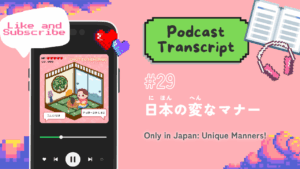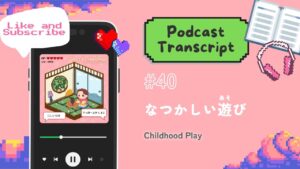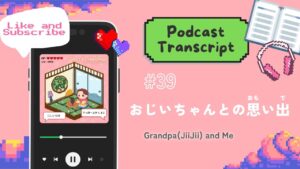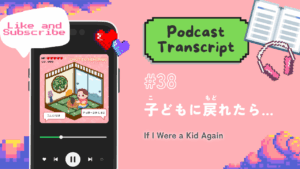おすすめの Google 拡張機能です!新しい言葉を勉強しましょう!
Here are the recommended Chrome extensions! Let’s learn new words here!
ポッドキャストプラットフォーム|Platforms of Podcast
こちらの記事は、配信中のポッドキャストのスクリプトです。
ぜひ、ポッドキャストを聞きながら読んでください。
 えみ先生
えみ先生もう聞いた人は、クイズをチェックしましょう!
ちょっとクイズ!|CHOTTO Quiz!
ポッドキャストを聞いた人は、ちょっとクイズを解いてみましょう。
むずかしいときは、下のスクリプトを読んで、もう一度クイズをチェックしてみてください。
【えいご】English Translation
Answer these quiz questions if you’ve listened to a new episode of my podcast.
If it was difficult, read the transcript below and try again.
❓ えみ先生が行っていたアメリカの高校は、何人の学生がいましたか?|How many students were there in the high school Emi-sensei went in the U.S.?
9800人の学生が いました。
There were 9,800 students.
❓ ホストマザーは、ご飯を炊くときに何を入れましたか?|What did the host mother put in when cooking rice?
お米と水と ココナッツオイルを入れて、ご飯を作っていました。
She added rice, water, and coconut oil to make rice!
❓ えみ先生が、アメリカのトイレでびっくりしたことは何ですか?|What made Emi-sensei surprised in the American bathroom?
ドアの上と下に大きなスペースがあることです。
They have large gaps at the top and bottom for the door.
ポッドキャストのスクリプト|Transcript of Podcast
エピソード30「私のカルチャーショック」
このポッドキャストは、初中級(Pre-Intermediate)レベルです。
おはようございます。こんにちは。こんばんは。
日本語の先生、エミです。
沖縄に帰ってきて、1週間が たちました。
家族とご飯を食べたり、友達と遊びに行ったり、毎日 予定があります。
沖縄に帰っている間のYouTube動画も作りたいので がんばります。
【えいご】English Translation
Good morning. Hello. Good afternoon.
I am a Japanese teacher, Emi.
I’ve been back in Okinawa for one week now.
I’ve been having meals with my family, going out with friends, and I have plans every day.
I also want to make YouTube videos while I’m back in Okinawa, so I’ll do my best.
来週は、私の夫も仕事が終わって 沖縄に来ます。
そして、ジャングリアに行く予定です。
ジャングリア、知っていますか?
ジャングリアは、沖縄にある恐竜のアミューズメントパークです。
恐竜はDinosaurです。
ジャングリアは、先月オープンしたばかりです。
まだ、新しいですね。
人がたくさんいるみたいですけど、楽しんでいきたいなと思います。
【えいご】English Translation
Next week, my husband will finish work and come to Okinawa too.
And we plan to go to “Junglia.”
Do you know “Junglia?”
Junglia is a dinosaur-themed amusement park in Okinawa.
“Kyōryū” is a Dinosaur.
Junglia just opened last month.
It’s still new.
It seems like there are a lot of people, but I think we’ll enjoy it.
ここで先週の質問をチェックしましょう。
先週は こんな質問をしました。
「日本の文化で、カルチャーショックを受けたことはありますか?」
こんな質問でした。
【えいご】English Translation
Alright, now let’s check last week’s question.
Last week, I asked this question:
“Have you ever experienced culture shock in Japan?”
That was the question.
さて、今日のテーマは「カルチャーショック」です。
みなさんは、カルチャーショックを経験したことがありますか?
カルチャーショックは、文化が違うときに びっくりすることです。
今日は、私のカルチャーショックについて話します。
【えいご】English Translation
Today’s topic is “culture shock.”
Have you ever experienced culture shock?
Culture shock is when you are surprised because the culture is different.
Today, I will talk about my own culture shock.
私は、18歳の時にアメリカに留学しました。
場所はデラウェア州というところです。
語学留学で、10カ月ぐらいアメリカにいました。
それが初めての外国でした。
私は、18歳の時は 英語もあまり話せませんでした。
だから、毎日ドキドキしていました。
そして、たくさんカルチャーショックがありました。
【えいご】English Translation
When I was 18, I studied abroad in the United States.
The place was a state called Delaware.
I went for language study and stayed in America for about ten months.
It was my first time in a foreign country.
When I was 18, I couldn’t speak much English.
So I felt nervous every day.
And I experienced a lot of culture shock.
一番びっくりしたのは、「学校のちがい」です。
アメリカの高校は、とっても大きかったです。
そのアメリカの学校には、なんと学生が 9800人もいました。
日本の高校では だいたい1000人ぐらいです。
私の高校も1000人くらでした。
だから、アメリカの学校は10倍の人数。
1000人と9800人。1万人に近いですね。
すごいですよね。
【えいご】English Translation
The biggest surprise for me was “the difference in schools.”
The American high school was very big.
That school had as many as 9,800 students.
In Japanese high schools, there are usually about 1,000 students.
My high school also had about 1,000 students.
So the American school had ten times more people—1,000 versus 9,800—almost 10,000.
Crazy, right?
でも、もっとびっくりしたことがあります。
それは、教室がいつも変わることです。
日本では、たとえば3年1組(Class 1)があって、ずっと同じ教室で勉強します。
たとえば、えみ先生は1組です。ずっと1組のクラスにいます。
だから、先生が教室に来ます。
学生は、教室に座ったままです。
でも、アメリカでは、学生が 毎時間 自分で教室に行きます。
【えいご】English Translation
But there was something even more surprising.
It was that the classrooms always change.
In Japan, for example, there is Class 3-1, and you always study in that same classroom.
For example, I would be in Class 1, and I’d always stay in that room.
So, in Japan, teachers come to the classroom, and the students stay seated.
But in America, students go to a different classroom for every period.
しかも、教室が広い学校の中にたくさんあります。
だから、最初のころは 教室を探すのが大変でした。
クラスメイトも毎回違うので、なかなか友達ができませんでした。
それが学校でのカルチャーショックでした。
【えいご】English Translation
Also, in a big school there are so many classrooms.
So, at first, it was hard to find my classrooms.
Since my classmates changed every time, it was also hard to make friends.
That was my school-related culture shock.
あと、食べ物のカルチャーショックもあります。
私は、アメリカでホストファミリーと 一緒に住んでいました。
ホストファミリーは日本の文化が好きで、日本の料理も作ってくれました。
でもある日、ホストマザーがご飯を作るのを見てびっくりしました。
ご飯はライスですね。Rice.
お米と水を 鍋に入れていました。
ここまでは日本と同じです。
日本も、お米とお水を 一緒に入れます。鍋に入れます。
日本は、でも炊飯器を使いますね。
でも、ここまでは普通です。お米とお水。
【えいご】English Translation
I also had food-related culture shock.
I lived with a host family in America.
My host family liked Japanese culture and even cooked Japanese food for me.
But one day, I was surprised when I saw my host mother cooking rice.
Rice is “gohan” in Japanese.
She put rice and water into a pot.
Up to this point, it was the same as in Japan.
In Japan, we put rice and water together in a pot, too.
Although we usually use a rice cooker,
so far, nothing unusual—rice and water.
でもホストマザーはそこにココナッツオイルを入れたんです。
「えっ、オイル入れるの?」と思いました。
日本では、ご飯を炊くときにオイルは入れません。
ココナッツオイルも、他のちがうオイルも入れません。
私は入れたことがありません。
もしかしたら、鍋でご飯を作るのが むずかしくて、おいしくするためにココナッツオイルを入れたのかもしれません。
でも、びっくりしました。
みなさんの国ではご飯をどうやって作りますか?
オイル入れますか?ぜひ教えてください。
【えいご】English Translation
But then, my host mother added coconut oil.
I thought, “What? Oil in rice?”
In Japan, we don’t put oil in when cooking rice—neither coconut oil nor any other oil.
I had never done that before.
Maybe cooking rice in a pot is difficult, and she added coconut oil to make it taste better.
But I was surprised.
How do people in your country cook rice?
Do you add oil? Please let me know.
もう1つ びっくりしたことがあります。
それは、ラーメンの作り方です。
私のホストブラザーは、インスタントラーメンを作ってくれました。
でも、スープの粉と 一緒に たくさんのバターを入れたんです。
私は日本で 味噌バターラーメンを食べたことがあります。
でも、日本の味噌バターラーメンは バターはちょっとだけ入れます。
5グラムぐらいです。
でも、私のホストブラザーは20グラムぐらいのバターを入れました。
びっくりしましたけど、おいしかったです。
でも、カロリーは たぶん高すぎると思います。
【えいご】English Translation
I had another surprise—about ramen.
My host brother made me instant ramen.
But along with the soup powder, he added a lot of butter.
I have eaten miso butter ramen in Japan before, but in Japan, we only add a little butter—about 5 grams.
But my host brother added about 20 grams of butter.
I was surprised, but it was delicious.
However, I think the calories were probably way too high.
この食べ物のカルチャーショックは、もしかしたら私のホストファミリーだけかもしれません。
みなさんは、ご飯とインスタントラーメンどうやって作りますか?
オイル入れますか?バター入れますか?
ぜひ レシピをシェアしてください。
【えいご】English Translation
Maybe this food-related culture shock was just my host family’s way of doing things.
How do you make rice or instant ramen in your country?
Do you add oil? Do you add butter?
Please share your recipes.
それからもう1つ、アメリカのトイレでもカルチャーショックがありました。
日本はウォシュレットとか、音を消すボタンがあって 有名ですよね。
日本のウォシュレットが有名なことは私も知っていました。
でも、トイレのドア、トイレのドアの隙間(スペース)にびっくりしました。
アメリカのトイレのドアは、ドアの上と下に大きいスペースがありますよね。
最初のころは、ほかの人に見られそうで ちょっとドキドキしていました。
【えいご】English Translation
And one more thing—I had culture shock with American toilets.
Japanese toilets are famous for things like washlets and sound-masking buttons.
I knew that Japanese washlets were famous.
But I was surprised at the gaps in the toilet doors.
In America, toilet doors have large gaps at the top and bottom.
At first, I felt nervous that other people might see me.
でも、日本のトイレはほんとに世界一だと思います。
みなさんの国のトイレはどうですか?
教えてください。
私が旅行に行くときのために勉強しておきたいです。
【えいご】English Translation
But I really think Japanese toilets are the best in the world.
What are toilets like in your country?
Please tell me.
I want to study this for when I travel.
みなさんは日本でどんなカルチャーショックを感じましたか?
日本に来たことがない人も、日本のことでびっくりしたことはありますか?
ぜひ メッセージやコメントで教えてください。
【えいご】English Translation
What kind of culture shock have you experienced in Japan?
If you’ve never been to Japan, is there anything about Japan that surprises you?
Please share your messages and comments.
では、今日も みなさんに 質問があります。
「あなたの国と日本で、家の中のルールは違いますか?」
日本やアジアの国は靴を脱いで家に入りますね。
こんな感じで、日本の家の中でのルールについて話します。
みなさんの家のルールも コメントで教えてください。
お願いします。
【えいご】English Translation
Now, I have a question for you today, as always.
“Are the rules inside houses different between your country and Japan?”
In Japan and some Asian countries, people take off their shoes before entering a house.
I will talk about house rules in Japan like this.
Please share your house rules in the comments.
Thank you.
今日のポッドキャストのスクリプトは、私のウェブサイトにあります。
ウェブサイトは、 en-nihongo.com です。
よかったら、ポッドキャストの感想や、質問の答えをコメントで教えてください!
じゃあ、また来週のポッドキャストで会いましょう。
じゃあね~!
【えいご】English Translation
A transcript for today’s podcast is on my website.
The website is en-nihongo.com .
I’d be very happy if you could share your thoughts/impressions or could answer the question I asked in this episode!
I’ll see you in the next episode.
Jaa ne-!







コメント|Comment